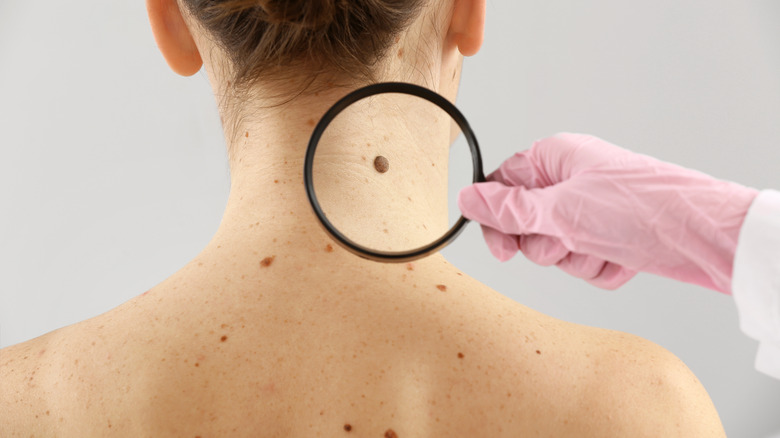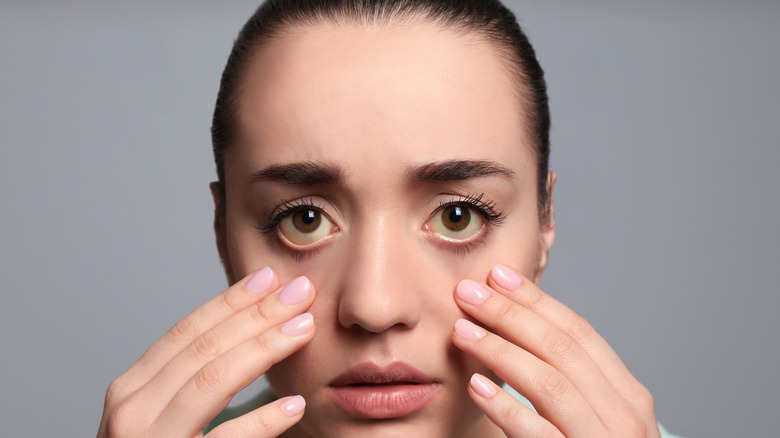If This Appears On Your Skin, It Could Be A Sign Of Liver Problems
You may not think about the health of your liver as much as you think about the health of your heart. However, your liver is just as important to your health as any other organ. If your liver isn't functioning properly, it can cause serious illness. According to the Cleveland Clinic, one out of 10 Americans have some form of liver disease.
The only organ larger than your liver is your skin. The job of the liver is to filter waste products from the nutrients in the blood. It produces bile, a substance that gets rid of waste and toxins like alcohol. If your liver isn't functioning properly, your body may show signs of it in ways that you may not think. Your skin shares a connection with the organs in your body, including the liver. Changes in your skin, even subtle ones, could be the first sign that there is something going wrong in the liver (via Johns Hopkins Medicine).
Spotty skin could be a sign of liver disease
It's important to pay close attention to your skin for monitoring your liver health. Some changes may not be as noticeable as others. Take note of any small, white spots with an irregular shape and a red halo around them that appear on the arms or legs. The spots may appear to be merely a skin irritation, but if they are Bier spots then that indicates a problem in the liver (via Best Life).
How can you tell if the spots on your skin are light spots or Bier spots? When pressure is applied to a Bier spot or when the limb covered with Bier spots is raised, the spots disappear. If the spots are merely a lightening of the skin, they will not disappear when you apply pressure to them or lift your arm or leg. Bier spots are caused by inflammation of the skin and veins, and are a sign of liver disease (per Best Life).
Liver disease could be the reason for itchy skin
Most of us think nothing of having to scratch an occasional itch here or there, but itchy skin is a common symptom of chronic liver disease. According to Healthline, pruritus is commonly seen in some liver diseases. Pruritus is an itchiness that just doesn't seem to go away, no matter how much you scratch.
There are theories as to why the skin may itch more if liver disease is present. It is thought that the increase in bile salt, serotonin, and histamine levels commonly seen in liver disease may be a cause for the increased itching. However, medications like antihistamines don't seem to relieve the itchiness (via Healthline).
Gender seems to have an impact on the likelihood of itchiness being a symptom of liver disease. A 2021 study published in Scientific Reports surveyed patients with liver disease about their experience with pruritus. The study concluded that pruritus affects males significantly more than females with liver disease.
Color changes on the skin could be a sign of liver disease
You may think of jaundice as something that newborn babies are treated for by being placed under a light. However, jaundice is one of the most noticeable skin changes associated with liver disease. Unlike Bier spots, jaundice is a much easier change to see on the skin.
According to WebMD, jaundice is a medical condition that shows up as yellow eyes or a yellow cast to the skin. Jaundice is a symptom of liver disease when the liver isn't able to process a chemical called bilirubin. When bilirubin isn't broken down properly, it accumulates in the blood. The overload of unprocessed bilirubin gives the skin and whites of the eyes a yellow color. It's important to note that skin changes may look different depending on how light or dark your skin is. Seasonal changes may affect your skin's color and texture as well. However, any skin change that looks abnormal should be further assessed by your doctor.




